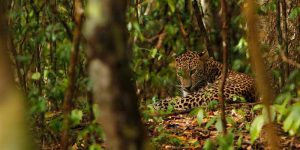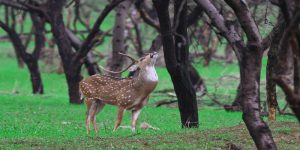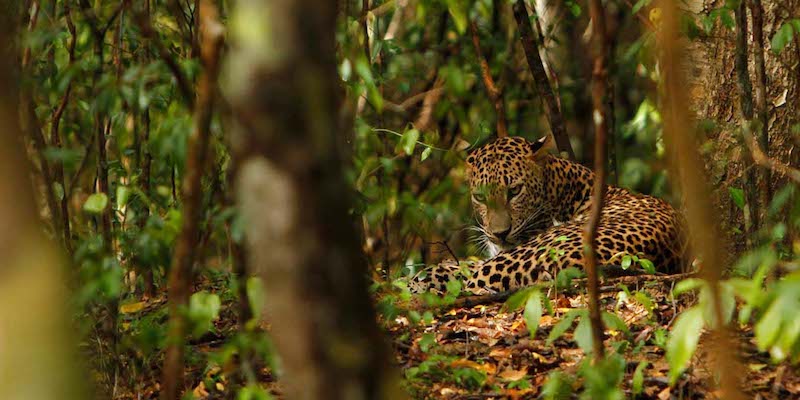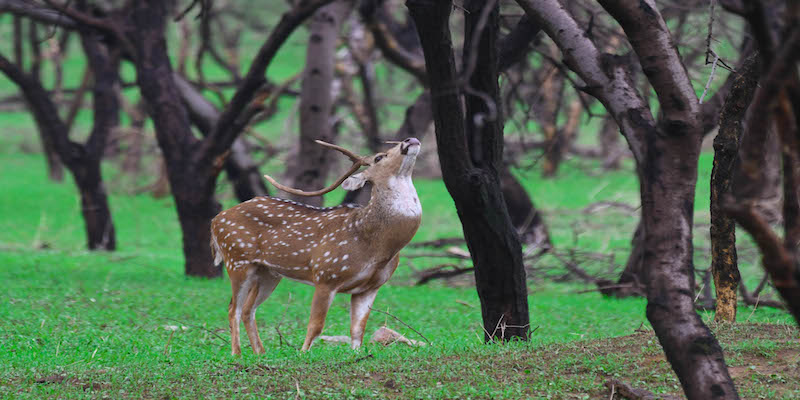JHALANA LEOPARD SAFARI
JHALANA LEOPARD SAFARI PARK
The Jhalana Leopard Safari or Jhalana Leopard Safari Park is India’s 1st Leopard Reserve located in Jaipur city of Rajasthan state, India. It is surrounded by Aravali hills, the oldest mountain series in India. Jhalana became a leopard reserve in 2017. The reserve is spread over an area of 20 square kilometers, with immense flora and fauna present in the park.

Leopard Sighting in Jhalana Leopard Safari
The Jhalana Leopard Safari currently hosts more than 40 leopards and 5 cubs! Other than leopards you can spot Striped hyenas, Indian civets, desert cats, jungle cats, desert foxes, jackals, porcupines, jungle rats, monitor lizards, and mongooses, Sambar deer, spotted deer (chital), Blue Bull (Nilgai) and a variety of snakes. You also have the opportunity of visiting Shikaar Audi, the three-storeyed hunting lodge of the Royal families of Jaipur. It is located right in the middle of the leopard reserve! It has an animal-spotting platform from where you can also enjoy the sunrise and sunset.
Safari in Jhalana became operational for visitors way back in 2016. With a good and healthy population of leopards, Jhalana safari park is the best place to sight a leopard. Sometimes it just happens within the 5 minutes of entering the park. Due to their diurnal nature Leopards can be seen in the daytime as they are not scared of the presence of jeeps and humans in their natural habitat. Jhalana safari park gains quick popularity among wild enthusiasts and holds a prominent place in wildlife tourism in the world. Nestled lazily in the foothills of the magnificent hilly terrain of Aravali, the park is the fantastic gateway to an adventure-filled holiday amidst the raw nature along with an unforgettable sighting of exotic wild animals.
Quick Facts about Jhalana Safari :
- Jhalana Leopard Reserve is the 1st Leopard reserve in India
- Jhalana Leopard Conservation Reserve has more than 40 Leopards including 5 cubs.
- The last tiger was shot in 1948.
- Jhalana is spread over an area of 20. square kilometers.
- In 2017 Jhalana was identified as a Leopard Reserve by Rajasthan Forest Department.
- Jhalana was opened for the first time for tourists in December 2016.
Flora & Fauna In Jhalana Safari Park:

Spotted Deer In Jhalana Leopard Reserve
Flora In Jhalana Leopard Reserve – narrow valleys of the Aravallis and sharp cliffs of hills dominate the landscape of Jhalana Leopard Reserve. The captivating natural surroundings of the forest of Jhalana and the tranquility here are extremely relaxing and a delight for the mind. The presence of such great wildlife in the urban region makes this land a different and unique site for nature enthusiasts.
Jhalana is a dry deciduous forest. The forest remains dry most of the time of the year as trees shed their leaves in the dry season and lush emeralds during the monsoons. The Jhalana forest is dominated by plants like juliflora (Prosopis juliflora) and khejri (Prosopis cineraria). The rapidly growing juliflora was initially planted to provide firewood for local villagers. However, trees do not support the growth of other grasslands and trees. The slanting valleys have more Local flora variety such as dhak (Butea monosperma), salar (Boswellia serrata), dhonk (Anogeissus pendula), and kumta (Acacia senegal).
Fauna In Jhalana Leopard Reserve – Obviously, the majestic Leopard is the prime and most covered mammal of this Jhalana Leopard Reserve, which is also the top predator of the region and who comes first in the food chain of the Jhalana forest reserve. Although the Leopard is known to be a nocturnal, solitary, shy, and rare-sighted predator with a master of stealth hunting skills, Leopards of the Jhalana National Park are diurnal in nature like tigers in Ranthambore and Sariska, due to which they are easily visible in the daytime making it one of the most visited reserve forests by Leopard lovers.
Apart from the Leopard, other big cats of the Jhalana Leopard Park are Leopard, Indian civets, desert cats, and jungle cats. This forest also provides food and shelter to other animals like Striped Hyena, desert foxes, jackals, porcupines, jungle rats, monitor lizards, mongooses, Sambar deer, spotted deer (chital), Blue Bull (Nilgai), and a variety of snakes.
A lot of rare bird species are found in Jhalana Leopard Reserve which makes this place a paradise for bird watching. Birds like the Indian Pitta, Dusky Eagle, Owl, Spotted Owlet, etc. can be seen in Jhalana National Park.
Best time to visit Jhalana Safari :
The Jhalana Leopard Reserve (The 1st Leopard reserve in India) is open for the safari tours for the visitors for all 12 months even in the monsoon season from 1st January to 31st December every year, according to the entry timings of that particular season. In Monsoon season most of the protected reserves in the country are closed, but here’s something to compensate for that.
Though one can enjoy the Jhalana Leopard Safari and savor the view of the majestic Leopard anytime, from November to April is considered the best time to visit Jhalana reserve as the weather is delightful at this point of time and nature is in its complete blossom around this time enhancing the beauty of the forest.
How to Reach Jhalana Leopard Reserve:
By Air: The Jaipur International airport is just 6 km away from Jhalana leopard reserve, which is approximately 15 minutes drive from the airport to Leopard Reserve. There are plenty of domestic and international flights connecting the pink city Jaipur to various cities in Indian and abroad. You can get a taxi, cab, or Bus at Jaipur airport to reach Jhalana Safari Park.
By Rail: The Jaipur Junction Railway station is the nearest rail station to the Jhalana Leopard Reserve. Which is around 11.7 km away from the forest. The station is a famous tourist station and is connected through direct trains from the major cities of India like Udaipur, Delhi, Mumbai, etc. For covering the distance from the station to Jhalana, you can hire a taxi or catch the local bus.
By Road: There is a direct road passing nearby the Jhalana forest reserve connecting it with cities like Mumbai, Ahmedabad, Udaipur, Kota, etc which is further connected with the major cities of India. So, If you are choosing the direct road trip from Delhi, Mumbai, or Udaipur, you can easily reach the Jhalana without any hassle. You can get on the road trip in your own vehicle or opt for the state Bus services to reach Jhalana.
Frequently Asked Questions:
Q. How many leopards are in the Jhalana safari?
A. There are 40 plus leopards in Jhalana Leopard Safari.
Q. Are kids allowed in the Jhalana safari?
A. Yes, kids are allowed in Jhalana Safari, and there is no age restriction on that. Children aged 6 and above are considered adults and charged the same as adults.
Q. How many leopards are there in Jaipur?
A. There are 70 plus leopards in Jaipur in the multiple conservation reserve such as Jhalana, Amagarh, and Nahargarh.
Q.Jhalana Leopard safari contact number?
A.You can contact Jhalana Leopard Safari on +91 96642 05052




